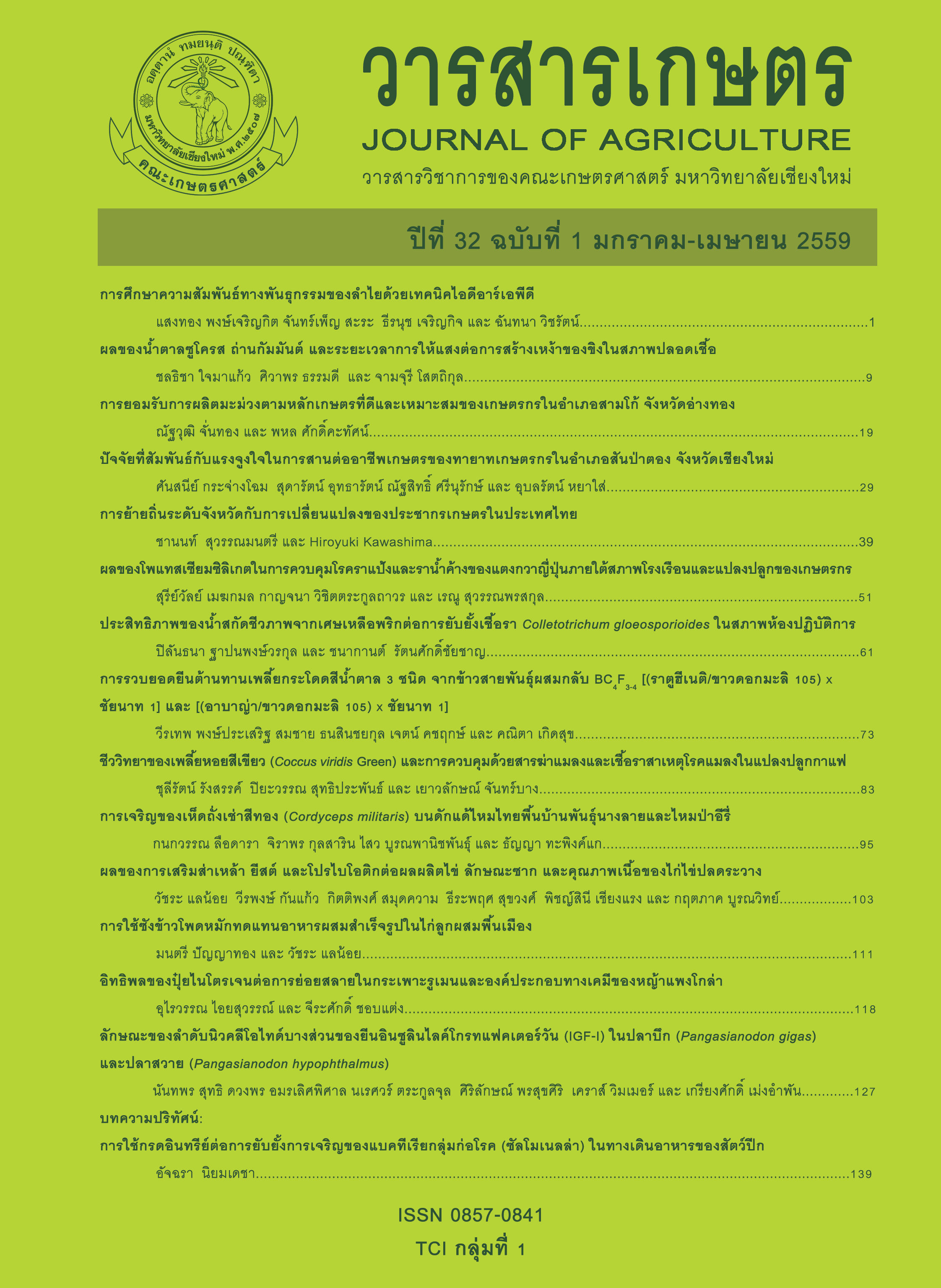การใช้กรดอินทรีย์ต่อการยับยั้งการเจริญของแบคทีเรียกลุ่มก่อโรค (ซัลโมเนลล่า) ในทางเดินอาหารของสัตว์ปีก
Main Article Content
บทคัดย่อ
ปัจจุบัน การปนเปื้อนของเชื้อซัลโมเนลล่าในผลิตภัณฑ์สัตว์ปีกนับเป็นปัญหาและอุปสรรคต่อการส่งออกเนื้อไก่ของประเทศไทยเป็นอย่างมาก การใช้สารปฏิชีวนะในอาหารหรือน้ำดื่มเพื่อการป้องกันโรคและกระตุ้นการเจริญเติบโตของสัตว์ อาจส่งผลให้เกิดการตกค้างในผลิตภัณฑ์สัตว์ได้ ซึ่งการใช้สารปฏิชีวนะถูกนำมาใช้กันอย่างกว้างขวางในปศุสัตว์สมัยใหม่และรักษาโรคของสัตว์ป่วย การใช้สารปฏิชีวนะที่เพิ่มขึ้น อาจส่งผลให้แบคทีเรียกลุ่มก่อโรคเกิดการดื้อยามีผลกระทบจากสัตว์สู่มนุษย์ และเป็นอันตรายต่อสุขภาพของมนุษย์ได้ จึงมีการศึกษาหลายทางเลือกในการลดการใช้สารปฏิชีวนะ เช่น สารเพิ่มความเป็นกรด (acidifier) โดยมีการใช้กรดอินทรีย์ในอาหารและน้ำดื่มของสัตว์ เพื่อเพิ่มการใช้ประโยชน์ของสารอาหาร การเจริญเติบโตของสัตว์ และประสิทธิภาพของการใช้อาหาร ช่วยเพิ่มความเป็นกรดในทางเดินอาหารของสัตว์ เพิ่มจำนวนแบคทีเรียกลุ่มแลคโตบาซิลลัสและยับยั้งการเจริญเติบโตของจุลินทรีย์กลุ่มที่ก่อโรค (ซัลโมเนลล่า) จากการศึกษาพบว่ากรดอินทรีย์สามารถกระตุ้นการเจริญเติบโตของสัตว์ และยับยั้งแบคทีเรียซัลโมเนลล่าในทางเดินอาหารของสัตว์ปีกได้
Article Details
เอกสารอ้างอิง
วารี นิยมธรรม อินทิราม กระหม่อมทอง และ เกรียงศักดิ์ พูนสุข. 2545. ประสิทธิภาพของสารละลายกรดอินทรีย์ในการยับยั้งการเจริญเติบโตของจุลินทรีย์ หน้า 63-68. ใน: ประมวลรายงานสัมมนาทางวิชาการเรื่องเทคโนโลยีชีวภาพเพื่อการพัฒนาการเกษตรกรรมไทย. กาฬสินธุ์.
ศักดิ์ชาย วงศ์เกียรติสุภาพ. 2543. ผลิตภัณฑ์ปศุสัตว์ปลอดสารพิษสหภาพยุโรป. ธุรกิจอาหารสัตว์ 17(72): 37-52.
สาโรจน์ ค้าเจริญ. 2547. อาหารและการให้อาหารสัตว์ไม่เคี้ยวเอื้อง. ภาควิชาสัตวศาสตร์. คณะเกษตรศาสตร์. มหาวิทยาลัยขอนแก่น. ขอนแก่น. 657 หน้า.
สุริยะ สะวานนท์. 2549. ผลของการเสริมจุลินทรีย์อีเอ็มหรือจุลินทรีย์ผลิตกรดแลคติกในอาหารสุกรต่อสมรรถภาพการผลิต การใช้ประโยชน์ได้ของโภชนะ รวมทั้งปริมาณและคุณสมบัติของสิ่งขับถ่าย. วารสารเกษตร 22(3): 235-244.
เสกสม อาตมางกูร. 2547. การใช้สารเสริมเพื่อช่วยปรับปรุงคุณค่าทางโภชนาการของอาหารสัตว์เอกสารประกอบการฝึกอบรมเทคนิคการผลิตอาหารสัตว์ขั้นสูง. มหาวิทยาลัยเกษตรศาสตร์ กำแพงแสน, นครปฐม. 82 หน้า.
อุดม ก๊กผล โสภณ เชิงสำราญ และ อมร เพชรสม. 2547. อินทรีย์เคมี.จุฬาลงกรณ์มหาวิทยาลัย, กรุงเทพฯ. 486 หน้า
อัจฉรา นิยมเดชา เปลื้อง บุญแก้ว และ มงคล คงเสน.2557. ผลของการเสริมส้มแขกในอาหารต่อสมรรถภาพการผลิต และค่า pH ในทางเดินอาหารของไก่เนื้อ.ในการประชุมวิชาการสัตวศาสตร์แห่งชาติ ครั้งที่ 3 “ปศุสัตว์ไทย ไร้พรมแดน” วันที่ 8-10 เมษายน 2557. หน้า 61.
Bailey, J. S. and E. Berrang. 1994. Hatchery-acquired Salmonella in broiler chicks. Poultry Science 73: 1153-1157.
Barnhart., E. T., D. J. Caldwell, M. C. Crouch, J. A. Byrd, D. E. Corrier and B. M. Hargis. 1999. Effect of lactose administration in drinking water prior to and during feed withdrawal on Salmonella recovery from broiler crops and ceca. Poultry Science 78: 211-214.
Bolduan. G. 1999. Principle of acidification of piglets feed. Pig News and Information 9: 381-385.
Byrd, J. A., B. M. Hargis, D. J. Caldwell, R. H. Bailey, K. L. Herron, J. L. McReynolds, R. L. Brewer, R. C. Anderson, K. M. Bischoff, T. R. Callaway, and L. F. Kubena. 2001. Effect of lactic acid administration in the drinking water during preslaughter feed withdrawal on Salmonella and Campylobacter contamination of broilers. Poultry Science 80:278-283.
Carson, J. A., J. S. Bailey and N. A. Cox. 1994. Transmission of Salmonella typhimurium during hatching of broiler chicks. Avian Diseases 38: 583-588.
Chansiripornchai, N., J. Sasipreyajan and T. Lekdumrongsak. 2000. Control of Salmonella infection. (Online) Avalible: http//www.pioneer.netserv.chula.ac.th (May 18, 2015).
Chapman, J. D. 1988.Probiotics,acidifier and yeast culture : a place for natural additives in pig and poultry production, pp. 219-233. In: T. P. Lyon (ed.) Biotechnology in the Feed Industry. McGraw HillBook Comp, Inc., New York.
Cox, N. A., J. R. Bailey, J. M. Mauldin, and L. C. Blankenship. 1990. Research note: Presence and impact of Salmonella contamination in commercial broiler hatcheries. Poultry Science 69: 1606-1609.
Freese, E., C. Sheu, and E. Galliers. 1973. Function of lipophylic acids as antimicrobial food additives. Nature 241: 321-325.
Hassan, H. M. A., M. D. Mohamed, A. W. Youssef, and E. R. Hassan. 2010. Effect of using organic acids to substitute antibiotic growth promoters on performance and intestinal microflora of broilers. Asian-Austral. Journal of Animal Science 23: 1348-1353.
Galluser, M., B. Crenischow, H. Dreyfus, F. Gosse, B. Guerols, J. Kachelhoffer, M. Doffoel and P. Raul. 1993. Comparison of different lipid substrates on intestinal. Journal of Animal Science 59: 2197-2203.
Ivan, E. I. 2003. Microbiology epidemiology and parasitology. Poultry International. 42: 33-37.
Marinho, M. C., M. M. Lordelo, L. F. Cunha and J. P. B. Freire. 2007. Microbial activity in the gut of piglets: I. Effect of prebiotic and probiotic supplementation. Livestock Science 108: 236-239.
Matho, G., S. Himathongkham, H. Riemann and P. Kass. 1997. Destruction of Salmonella enteritidis in poultry feed by combination of heat and propionic acid. Poultry Science 41: 58-61.
Miyamoto, T., E. Baba, M. Tanaka and K. Sasai. 1997. Salmonella enteritidis contamination of eggs from hens inoculated by vaginal, clocal, and intravenous routes. Avian Diseases 41: 296-303.
Odle, J. 1999. Medium-chain triglycerides: a unique energy source for neonatal pigs. Pig News Information 20: 25-32.
Ogunwole, O. A., O. A. Abu and I. A. Adepoju. 2011. Performance and carcass characteristics of broiler finishers fed acidifier based diets. Pakistan Journal of Nutrition 10(7): 631-636.
Partanen K., H. Siljander-Rasi, T. Alaviuhkola, K. Suomi and M. Fossi. 2002. Performance of growing-finishing pigs fed medium or high fibre diets supplemented with avilamycin, formic acid or formic acid-sorbate blend. Livestock Production Science 73: 139-152.
Phillip, A. S., S. N. Talmadge, K. K. Linda, B. J. Zelpha and N. B. Joseph. 1982. Influence of temperature moisture and propionic acid on mold growth and toxin production on corn. Poultry Science 62: 491-423.
Ricke, S. C. 2003. Perspectives on the use of organic acids and short chain fatty acids as antimicrobials. Poultry Science 82: 632-639.
Risley, C. R., E. T. Kornegay, M. D. Lindemann and S. W. Weakl. 1991. Effects of organic acid with and without a microbial culture on performance and gastrointestinal tract measurements of weanling pigs. Journal of Animal Science 35: 259-270.
Rot, F. X. and M. Kirchgessner. 1989. Organic acid application in feeds without antibiotica. Feed Mixture 8: 15-17.
Russell, S. M. 2002. Intervention strategied for reducing Salmonella prevalence; reducing Salmonella prevalence on ready-to-cook chicken requires a multi-hurdle approach at all stages of live production and processing. WATT Poultry USA. 28-45.
Saki, A. A., R. N. Harcini, E. Rahmatnejad and J. Salary. 2012. Herbal additives and organic acids as antibiotic alternatives in broiler chickens diet for organic production. African Journal of Biotechnology 11(8): 2139-2145.
Sharma, R., U., Schumarcher, V. Ronaasen and M. Coates. 1995. Rat intestinal mucosal responses to a microbial flora and different diets. Gut. 36: 209-214.
Takase, S. and T. Goda. 1990. Effects of medium-chain triglycerides on brush border membrane-bound enzyme activity in rat small intestine. Journal of Nutrition 120: 969-976.
Tarazi, Y. H. and K. Alshawabkeh. 2003. Effect of dietary formic and propionic acids mixture on limiting Salmonella pullorum in layer chicks. Asian-Australasian Journal of Animal Science 2003.16: 77-82.
Thompson, J. L. and M. Hinton. 1997. Antibacterial activity of formic and propionic acids in the diet of hens on salmonellas in the crops. British Poultry Science 38: 59-65
Waldroup, A., S. Kaniawato and A. Mauromoustakos. 1995. Performance characteristics and microbiological aspects of broiler fed diets supplemented with organic acids. Journal of Food Protection 58: 482-489.


